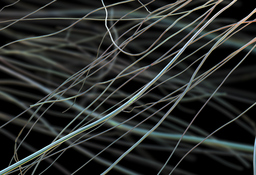Templated Synthesis of Shape-Controlled Polymeric Nanofibers by Chemical Vapor Deposition into Liquid Crystals
TECHNOLOGY NUMBER: 6988

OVERVIEW
A method for carrying out nanowire synthesis on films of liquid crystals- Permits precise control of the diameter and length of manufactured nanowire s
- Nanowires that are easy to process and which can incorporate functional molecules
BACKGROUND
The field of material design has been revolutionized with increasing control of nanoscale geometries. Adjustments to nanoscale features allow for control over the electrical and optical properties of many materials. In particular, the electron transport across one-dimensional nanowires can be exploited to create new materials. While nanowires are thought to have one-dimensional geometry, their extreme length affects their electrical, optical, and mechanical properties. Nanowires can be incorporated in a wide range of technology, from photovoltaics to biochemical sensors or touch screen displays. A need exists for improved nanowire synthesis that takes advantage of its specific properties.
INNOVATION
Researchers have invented a manner for carrying out nanowire synthesis on films of liquid crystals. This new technology allows for greater control over polymer nanowire than any previously demonstrated technique. This method works with specific templates and standard chemical vapor deposition polymerization in a one-step process to create uniformly shaped nanowires. The novel feature of this synthesis includes chemical vapor deposition with adjustments in the geometry and type of a liquid crystal controlling the shape and chirality of the resulting nanowires. This process can control the nanowire length from 200 nanometers to 100 microns. As compared to metallic nanowires, these polymer nanowires are easier to process, and the surface properties can be readily adapted by incorporating functional molecules.
The nanowires possess the shared characteristics of electrical conductance and optical transparency, allowing them to be dispersed on flexible, polymer films. The polymer can be functionalized with different reactive surface groups, which could presumably help in tailoring materials for specific applications. The investigators can create nanowires in the form of aligned nanowire arrays supported on a solid, in the form of nanowire mats supported on porous materials, or as individual free-standing nanowires. The process works on a range of solids, including materials that are flexible or have complex geometry. And, it requires a single step and does not need any additives, catalysts, or volatile solvents. As compared to metallic nanowires, these polymer nanowires are easier to process and the surface properties can be readily adapted by incorporating functional molecules.